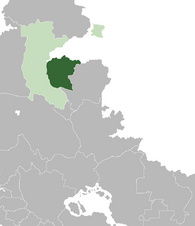Copacaban Republic
Copacaban Republic Kiyuribzi Kopakaban | |
|---|---|
|
Flag | |
Motto: Music - Passion - Nation | |
Anthem: Copacabana (1993 Remix) | |
 | |
| Capital | Waxbal |
| Largest | Duxamel |
| Official languages | Copacaban |
| Auxiliary languages | Standard Coscivian Telontec |
| Ethnic groups (2024) | Copacaban ~75% Telontec ~15% Others ~10% |
| Demonym(s) | Copacaban |
| Government | Provisional government |
• Prime Executive | Lola Kíxzxludurxazsz |
• High Commissioner | B.H. Propoxur |
| Establishment | |
• Independence from Telonaticolan | 2024 |
| Population | |
• Estimate | ~X million? |
| Currency | Telonaticolani caracol Cronan lira |
| Time zone | Punthite Central Time |
• Summer (DST) | UTC+0 |
| Date format | dd-mm-yyyyy |
| Driving side | left side |
The Copacaban Republic is a sovereign state in eastern Crona.
History
For most of recorded history, the area that is now the Copacaban Republic has been the abode of the Copacabans, a Faucho-Masquetecan people believed to have migrated from the eastern plains of what is now Varshan through the Yaviža Gap at some point during the early Cronan Bronze Age, conquering and absorbing the previous inhabitants, currently theorised to have been Elonogean speakers.
During the era of modern nation-state formation in Crona, the Copacaban lands became incorporated into Telonaticolan.
By the beginning of 2024, Telonaticolan had become a three-way battleground in the Final War of the Deluge, with the recognised government of Telonaticolan (supported by Urcean and Kiravian peacekeepers) and the far-left Telonaticolan People's Army at war with the invading Varshani army and one another. Although the Varshani incursion was flagging by 2024, concurrent gains in military momentum by the TPA and rapid advances by Allied forces in Varshan put pressure on Urcea and Kiravia to scale back their peacekeeping presence in Telonaticolan. Urcean-led negotiations with the local parties produced a deal under which almost all Urcean peacekeepers would withdraw from the country, leaving only a small frontline presence to maintain encirclement of the remaining Varshani forces, in exchange for recognition of the Copacaban people's right to national self-determination. In tandem, Kiravian peacekeeping forces in Telonaticolan were withdrawn from the rest of the country and transitioned to a security and stabilisation assistance mission in the Copacaban territories. Traditional leaders and civil officials in the region, facilitated and encouraged by the Kiravian Foreign Service, promulgated a Declaration of Sovereignty pursuant to the aforementioned agreement, which was ratified in a hastily-organised referendum on St. Patrick's Day, 2024 and took full effect April 15, 2024.
Subsequently, the Copacaban Provisional Government began operations under the leadership of Lola Kíxzuldurxaz, a celebrated advocate for Copacaban self-determination, women's empowerment, and sustainable development hailing from an influential chiefly family. With substantial assistance from the Overseas Governance Executive and Overseas Development Executive, Horizon Division, Copacaban embarked on a project of state-building and nation-building to consolidate its nascent independence. As part of this process, the Republic decreed a right of return for ethnic Copacaban from elsewhere in Telonaticolan. At the same time, Kiravian operatives worked to "cannibalise" the faltering Telonaticolani state to the benefit of Copacaban, facilitating defections from the Telonaticolan military and bureaucracy, inducing members of professional and mercantile classes to seek asylum in Copacaban or Mid-Atrassic Crona, and in many cases simply plundering funds and other assets to help prop up the new state.
Society & Culture
Copacaban society is primarily made up of ethnic Copacaban people, and its culture derives primarily from their traditions, customs, and language, albeit with significant demographic contributions and cultural influences from other parts of former Telonaticolan and neighbouring societies.
No census has yet been conducted in the Copacaban Republic, and statistics generated under Telonaticolan administration are largely dated and/or methodologically flawed. The International Reconnaissance Agency estimates that around 75-80% of the country's population are ethnic Copacaban, with the remaining 20-25% belonging to other Cronite ethnic groups, mainly Telontec and other peoples native to Telonaticolan. The non-Copacaban population is mainly urban and settled in the region while it was part of Telonaticolan, though a rapidly growing contingent are recent emigrés fleeing the country's civil war. A small, pre-Deluge Coscivian community, numbering no more than 3,000 or so, owes its origins to previous Kiravian mercantile activity in Yordest Bay, and a growing number of Coscivian- and Celtic-Kiravians are present in the country on a more temporary basis as part of development assistance programmes.
According to IRA estimates, around 40-50% of the Republic's population (and a supermajority of ethnic Copacaban) follow M'acunism, mainly according to the local usages of the Copacaban, and 10-20% follow other native Cronite traditions, such as the worship of Xzibit and the Great Lobster. As in Chappaqua, Copacaban's coastal location and longer exposure to Old World contact and missionary activity have left a larger Christian minority relative to other areas of former Telonaticolan. The Christian population is estimated at 20-30% and believed to be mainly Catholic with an Insular Apostolic and Mercantile Protestant minority. Exact figures on religious adherence are difficult to arrive at due to data availability and the prevalence of syncretism in the country.
Economy
The Copacaban Republic has a modest economy driven mostly by agriculture, the exploitation of some minor mineral reserves, and light manufacturing. Key exports include bauxite, tobacco, gabbana fruit, textiles, frozen turkeys, and kidney beans.
The Republic does not currently issue its own currency. Both the Telonaticolani caracol and Cronan lira circulate widely in the country. Government accounting is in lire, as most of the state budget comes from saar-denominated Kiravian foreign aid and the Cronan lira is pegged against the saar.
Military
The de facto defence of the Copacaban Republic is currently provided by the Kiravian Armed Forces, with assistance from the Chappaqui People's Liberation Army. The Copacaban Republican Army is currently under construction with the aid of Kiravian military advisors.
